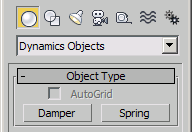Spring : GeometryClass
| Value > MAXWrapper > Node > GeometryClass > Spring |
0-Reference Objects (Choose this when binding the spring to two objects.)
1-Free Spring (Choose this when using the spring as a simple object that's not bound to other objects or used in a dynamics simulation.)
The straight-line height or length of the spring when it is not bound. This is not the actual length of the spring's wire.
The overall diameter of the spring, as measured at the center of the wire. (The diameter of the wire itself has no effect on this setting.)
The number of full 360-degree turns in the spring.
Sets the direction of the turns in the spring:
Sets the segmentation method of the springs:
0-Automatic Segments (Choose this option to force each turn of the spring to contains the same number of segments. Thus, if you increase the number of turns, the number of segments also increases.)
1-Manual Segments (When this option is chosen, length of the spring contains a fixed number of segments, no matter how many turns in the spring. Thus, as you increase the number of turns, you must manually increase the number of segments to maintain a smooth curve.)
The number of segments in each 360-degree turn of the spring.
The total number of manual segments in the spring.
Set smoothing method for spring:
0-All (All surfaces are smoothed.)
1-None (No smoothing is applied.)
2-Sides (Smoothing runs along the length of the wire, but not around its perimeter.)
3-Segments (Smoothing runs around the perimeter of the wire, but not along its length.)
When on, the object appears in the rendering; when off, the object does not appear:
Turn on/off generate texture coordinates
The number of sides that make up the cross section of the round wire.
Determines the width of the rectangular cross section.
Determines the depth of the rectangular cross section.
When combined with .Rectangular_Fillet_Sides , this lets you fillet (round) the corners of the cross section.
The number of segments in the fillet.
Rotates the angle of the cross section along the entire length of the spring.
Determines the width of the cross section.
Determines the depth of the cross section.
The number of segments that make up the rounded side of the D-shape.
When combined with .D_Section_Wire_Fillet_Sides , this lets you fillet (round) the corners of the cross section.
The number of segments in the fillet.
Rotates the angle of the cross section along the entire length of the spring.
Specifies the height (or length) at which the spring is "relaxed" and therefore contributes no force—either compression or extension.
The amount of force exerted per unit change in length with respect to the Relaxed Hgt value. This could also be described as the measure of force-per-units-change in length as compared to the Relaxed Length.
Sets the Units for the K constant:
Lets you specify the type of force you want the spring to exert. While most springs actually provide both compression and extension force, if your simulation requires only one, you can save calculation time by using one instead of both.
0-Compression Only (This type of spring provides only expansive force when its length is shorter than the specified Free Length.)
1-Extension Only (Provides contractive force when its length is greater than the specified Free Length.)
2-Both (Provides both expansive and contractive force, depending on the variation from Relaxed Hgt.)
Turn on/off generate texture coordinates:


